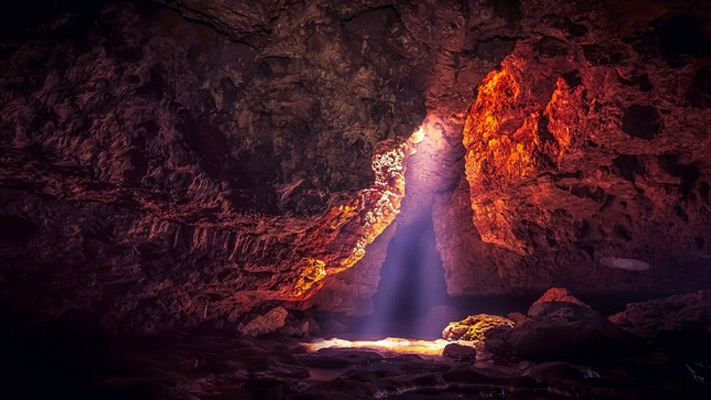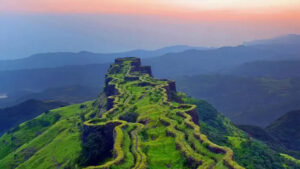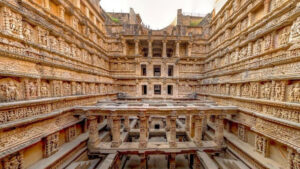15 CAVES IN INDIA THAT ARE AN ABSOLUTE MUST VISIT – JOURNEY INTO THE DEPTHS

India is home to a myriad of caves, each with its own fascinating history, natural beauty, and cultural significance. These ancient underground marvels have captivated the imagination of explorers, archaeologists, and spiritual seekers for centuries. From the intricately carved cave temples to the majestic natural formations, India’s caves offer a glimpse into its rich heritage and diverse landscapes. Whether you’re seeking spiritual enlightenment, archaeological wonders, or simply an awe-inspiring adventure, the caves of India beckon you to uncover their hidden treasures. Step into the depths and embark on a journey through time as you explore these ancient sanctuaries carved by nature and human hands alike.

1. Ajanta Caves, Maharashtra
The Ajanta Caves in Maharashtra, India, are a UNESCO World Heritage Site and a masterpiece of ancient Buddhist art and architecture. Dating back to the 2nd century BCE, these caves consist of exquisite rock-cut monasteries and prayer halls adorned with intricate paintings and sculptures. The paintings depict the life of Buddha, celestial beings, and various mythological stories. The Ajanta Caves are a testament to the skill and creativity of the artists of that era and offer a captivating glimpse into the rich cultural and religious history of India.
2. Ellora Caves, Maharashtra
The Ellora Caves in Maharashtra, India, are a UNESCO World Heritage Site renowned for their remarkable rock-cut architecture and religious significance. These caves date back to the 6th to 10th centuries and showcase a unique fusion of Hindu, Buddhist, and Jain art. The complex includes 34 caves, with stunning temples, monasteries, and shrines carved into the solid rock of the Charanandri Hills. Highlights include the awe-inspiring Kailash Temple, the largest monolithic structure in the world, featuring intricate carvings and elaborate sculptures. The Ellora Caves are a testament to the cultural and artistic heritage of ancient India and are a must-visit for history and architecture enthusiasts.
3. Elephanta Caves, Maharashtra
Located on Elephanta Island in Maharashtra, the Elephanta Caves are a collection of ancient rock-cut caves dedicated to Lord Shiva. Designated as a UNESCO World Heritage Site, these caves are known for their impressive sculptures and intricate carvings. The main attraction is the magnificent Trimurti sculpture, a three-headed depiction of Lord Shiva, which stands as a centerpiece in the main cave. The Elephanta Caves provide a fascinating glimpse into the artistic and religious traditions of ancient India, making them a popular destination for both history enthusiasts and spiritual seekers. Accessible by a short ferry ride from Mumbai, visiting the Elephanta Caves is a memorable experience.
4. Badami Caves, Karnataka
The Badami Caves, located in Karnataka, India, are a group of rock-cut cave temples dating back to the 6th and 7th centuries. Carved out of sandstone cliffs, these caves showcase a blend of Hindu and Jain architectural styles. There are four main caves, each dedicated to different deities, adorned with intricate carvings and sculptures. The highlight of the Badami Caves is Cave 1, dedicated to Lord Shiva, which features a stunning sculpture of Nataraja, the cosmic dancer. With their unique rock-cut architecture and religious significance, the Badami Caves offer a captivating glimpse into the rich history and artistic heritage of the region.

5. Karla Caves, Maharashtra
Located in Maharashtra, India, the Karla Caves are a complex of ancient rock-cut caves dating back to the 2nd century BCE. These caves are known for their Buddhist significance and showcase magnificent architecture and intricate sculptures. The highlight of the Karla Caves is the Chaitya Hall, a grand prayer hall with towering pillars, beautiful carvings, and a magnificent stupa. The caves also feature viharas (monastic cells) where Buddhist monks would reside. Surrounded by scenic hills and lush greenery, the Karla Caves offer a serene and spiritual ambiance, attracting visitors and history enthusiasts alike.
6. Bhimbetka Caves, Madhya Pradesh
Located in Madhya Pradesh, India, the Bhimbetka Caves are a UNESCO World Heritage Site known for their ancient rock art and paintings. These caves have evidence of human habitation dating back over 30,000 years, making them one of the oldest known rock art sites in the world. The caves feature thousands of vibrant paintings depicting scenes from everyday life, animals, hunting scenes, and religious rituals. The art provides valuable insights into the culture, lifestyle, and artistic capabilities of prehistoric humans. Exploring the Bhimbetka Caves offers a unique opportunity to step back in time and appreciate the rich artistic heritage of early human civilizations.
7. Udayagiri and Khandagiri Caves, Odisha
The Udayagiri and Khandagiri Caves are a fascinating complex of rock-cut caves located in Odisha, India. These caves date back to the 2nd century BCE and were originally used as residential retreats for Jain monks. Udayagiri, meaning “Sunrise Hill,” and Khandagiri, meaning “Broken Hill,” are adjacent hills that house a total of 33 caves, each with its own unique features. The caves showcase intricate carvings, inscriptions, and sculptures depicting Jain deities, animals, and mythological figures. Exploring these caves provides a glimpse into ancient Jain culture and offers panoramic views of the surrounding landscape. The Udayagiri and Khandagiri Caves are a significant historical and archaeological site, attracting visitors with their architectural marvels and cultural significance.
8. Tabo Caves, Himachal Pradesh
Located in Himachal Pradesh, India, the Tabo Caves are a cluster of ancient meditation retreats associated with Tabo Monastery. These caves are nestled in the picturesque Spiti Valley and are renowned for their historical and spiritual significance. Dating back over a thousand years, the caves feature rock-cut chambers adorned with beautiful Buddhist murals and intricate paintings. The serene and tranquil ambiance of the Tabo Caves makes them an ideal spot for meditation and reflection. As part of the Tabo Monastery complex, these caves offer visitors a glimpse into the rich Buddhist heritage and provide a peaceful retreat in the midst of the stunning Himalayan landscape.
9. Amarnath Cave, Jammu and Kashmir
Situated in Jammu and Kashmir, India, the Amarnath Cave is a revered Hindu pilgrimage site dedicated to Lord Shiva. Located at an altitude of around 3,888 meters (12,756 feet), the cave is believed to be the abode of Lord Shiva and holds great spiritual significance. The highlight of the cave is the naturally formed ice lingam, which forms and melts during different seasons. Each year, thousands of devotees undertake a challenging trek to reach the cave and offer their prayers to Lord Shiva. The journey to the Amarnath Cave is not only a test of faith but also an opportunity to experience the breathtaking beauty of the Himalayan region.

10. Undavalli Caves, Andhra Pradesh
The Undavalli Caves, located in Andhra Pradesh, India, are a remarkable example of rock-cut architecture. Dating back to the 4th to 5th centuries, these caves are carved out of a sandstone hillside and showcase a unique blend of Buddhist and Hindu architectural styles. The main highlight of the Undavalli Caves is a monolithic rock-cut temple dedicated to Lord Vishnu. The intricate carvings, sculptures, and ornate pillars within the caves add to their artistic beauty. The site also features a large reclining statue of Lord Vishnu, which is a significant attraction for visitors. The Undavalli Caves are a testament to the ancient craftsmanship and religious harmony that existed in the region.
11. Kanheri Caves, Maharashtra
The Kanheri Caves, situated in Maharashtra, India, are an impressive complex of rock-cut caves and Buddhist monastic settlements. Dating back to the 1st century BCE, these caves served as a center for Buddhist learning and meditation. Located within the lush green surroundings of Sanjay Gandhi National Park, the Kanheri Caves boast over 100 caves with intricate carvings, stupas, and prayer halls. The highlight is the Great Chaitya, a massive prayer hall with striking architecture. The caves also provide insight into the daily life of Buddhist monks, with cells, kitchens, and water cisterns still visible. The tranquil atmosphere and historical significance of the Kanheri Caves make them a must-visit destination for history enthusiasts and nature lovers alike.
12. Belum Caves, Andhra Pradesh
The Belum Caves, located in Andhra Pradesh, India, are a fascinating underground marvel and one of the longest caves in the country. These natural limestone caves span a length of over 3 kilometers, with intricate passages, chambers, and stalactite formations. Belum Caves are known for their stunning stalactite and stalagmite formations, creating a surreal environment. Visitors can explore various sections of the cave, including the Meditation Hall, Thousand Hoods Chamber, and Saptasvarala Guha, which is believed to produce musical sounds. The caves also have historical and archaeological significance, with artifacts dating back to prehistoric times found within. The Belum Caves offer a unique and captivating experience for adventurers, nature enthusiasts, and history buffs alike.
13. Jogeshwari Caves, Maharashtra
The Jogeshwari Caves, located in Maharashtra, India, are an ancient rock-cut cave complex known for their historical and archaeological significance. Dating back to the 6th century, these caves are dedicated to Lord Shiva and are adorned with intricate carvings and sculptures. The main cave features a lingam and a beautifully carved Nandi bull. The Jogeshwari Caves also have smaller cells and chambers with striking rock-cut architecture. The caves showcase a blend of Hindu and Buddhist influences, making them an interesting site for religious and cultural exploration. Nestled amidst scenic surroundings, the Jogeshwari Caves offer visitors a chance to delve into the rich history and architectural heritage of the region.
14. Edakkal Caves, Kerala
The Edakkal Caves, located in Kerala, India, are a unique archaeological site that holds a glimpse into prehistoric human civilization. These caves are nestled amidst the picturesque Ambukuthi Hills and are renowned for their ancient rock carvings. The carvings depict human figures, animals, and various symbols, providing valuable insights into the lives and beliefs of the people who lived here thousands of years ago. Accessible through a moderately challenging trek, the Edakkal Caves offer visitors a chance to explore the natural beauty of the region while uncovering the mysteries of our ancient past. The caves are not only a testament to the rich cultural heritage of Kerala but also a captivating destination for history and nature enthusiasts.

15. Mawsmai Cave, Meghalaya
Mawsmai Cave, located in Meghalaya, India, is a popular tourist attraction known for its natural rock formations and enchanting underground experience. The cave is a part of the Khasi Hills and is characterized by its narrow passages, limestone formations, and impressive stalactite and stalagmite formations. Inside the Mawsmai Cave, visitors can witness unique rock formations that resemble various shapes and forms. The cave is illuminated with artificial lights, adding to the mystical atmosphere. Exploring the Mawsmai Cave offers a thrilling adventure as visitors navigate through the narrow passages and marvel at the geological wonders that have formed over thousands of years. It is a must-visit destination for nature lovers and adventure seekers visiting Meghalaya.


















































